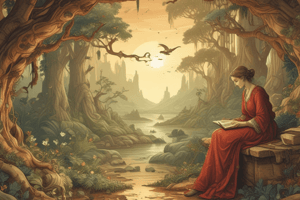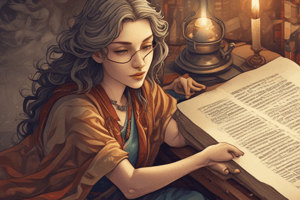Podcast
Questions and Answers
What literary device combines two contradicting words without necessarily proving them to be true?
What literary device combines two contradicting words without necessarily proving them to be true?
- Oxymoron (correct)
- Paradox
- Simile
- Irony
Which term specifically refers to readers knowing information that the characters in a story do not?
Which term specifically refers to readers knowing information that the characters in a story do not?
- Metonymy
- Dramatic Irony (correct)
- Verbal Irony
- Situational Irony
Which figure of speech involves giving human-like characteristics to non-human entities?
Which figure of speech involves giving human-like characteristics to non-human entities?
- Personification (correct)
- Hyperbole
- Allusion
- Metonymy
Which type of diction emphasizes the careful and sophisticated use of language?
Which type of diction emphasizes the careful and sophisticated use of language?
Which of the following refers to the use of exaggeration to create humor or emphasis?
Which of the following refers to the use of exaggeration to create humor or emphasis?
Which type of imagery specifically relates to the sense of taste?
Which type of imagery specifically relates to the sense of taste?
What is the term for a part being used to signify the whole, or vice versa?
What is the term for a part being used to signify the whole, or vice versa?
Which type of diction is characterized by informal language linked to a specific social group or context?
Which type of diction is characterized by informal language linked to a specific social group or context?
Which literary device allows a writer to create comparisons using 'like' or 'as'?
Which literary device allows a writer to create comparisons using 'like' or 'as'?
What is the primary purpose of using concrete diction in writing?
What is the primary purpose of using concrete diction in writing?
Flashcards are hidden until you start studying
Study Notes
Writing Precision and Diction
- Accuracy involves careful word selection to convey precise meaning.
- Precision emphasizes using exact language to communicate effectively.
- Appropriateness reflects the suitability of words for achieving a text's purpose.
- Concreteness stimulates the senses, enhancing reader engagement.
Types of Diction
- Formal Diction: Employs sophisticated and professional language.
- Informal Diction: Uses conversational and realistic language.
- Colloquial Diction: Incorporates informal language tied to specific regions or time periods.
- Slang Diction: Language restricted to particular social groups or contexts.
- Pedantic Diction: Features highly complex or scholarly language.
- Poetic Diction: Descriptive and lyrical language creating melodic sound.
- Concrete Diction: Utilizes denotative meaning for clarity.
- Abstract Diction: Includes intangible, conceptual words.
Figurative Language and Literary Devices
- Imagery: Creates visual representations through words.
- Types of Imagery:
- Visual (sight)
- Auditory (hearing)
- Olfactory (smell)
- Gustatory (taste)
- Tactile (touch)
- Kinesthetic (motion)
- Organic (sensation and emotion)
Figures of Speech
- Simile: Direct comparison using "like" or "as."
- Metaphor: Asserts two objects are identical.
- Synesthesia: Describes sensory experiences using intertwined senses.
- Oxymoron: Pairs contradicting terms.
- Paradox: Presents contradictions that can be true.
- Irony: Expresses something contrary to the intended meaning.
- Verbal Irony: Opposite of what is meant.
- Situational Irony: Outcome is contrary to what was expected.
- Dramatic Irony: Audience knows something characters do not.
- Personification: Attributes human traits to non-human entities.
- Apostrophe: Speaks to absent or non-existent individuals.
- Allusion: References historical, mythological, or political figures.
- Metonymy: Substitutes the name of one object for another closely related.
- Synecdoche: Signifies a whole or part by using its fragment or whole.
- Anaphora: Repetition of a phrase or word at the beginning of successive clauses.
- Hyperbole: Intentional exaggeration for emphasis.
- Litotes: Expresses positive by negating its opposite.
- Pun or Paronomasia: Wordplay for humorous effect.
Elements of Poetry
- Poetry is a rhythmic and imaginative art form.
- William Wordsworth defined poetry as using language distinctively from prose.
- Defamiliarization: Makes familiar things appear strange or new.
- Figurative Language: Incorporates various figures of speech.
- Poetic Form: Distinguishes poetry from prose.
- Structure of Poetry:
- Verse: Similar to a line or stanza in poetry.
- Meter: Refers to the number of syllables in a line.
- Rhyme: Similar final sounds; involves rhyme schemes.
- Line Break: Indicates where a poet chooses to end a line.
- End-Stopped Line: Concludes a thought or sentence.
- Enjambment: Continues a sentence beyond the line break.
Types of Poetry
- Lyric Poetry: Expresses personal emotions and thoughts.
- Narrative Poetry: Tells a story through verse.
- Dramatic Poetry: Intended for performance, rich in emotion.
- Various forms of poetry are defined by their rhyme schemes and structures, including couplets, tercets, quartets, and more.
Techniques and Literary Devices in Poetry
- Sensory Devices: Create vivid experiences appealing to the senses (imagery, metaphor, simile).
- Sound Devices:
- Alliteration: Repetition of consonant sounds.
- Assonance: Repetition of vowel sounds.
- Onomatopoeia: Words that imitate sounds.
Innovative Techniques in Poetry
- Found Poetry: Forms from words taken from non-poetic sources.
- Blackout Poetry: Selects and obscures text to create new messages.
- Erase Poetry: Removes words to create new meanings.
- Micro Poetry: Very short poems focused on brevity.
- Slam Poetry: Competitive performance art form.
- Spoken Word Poetry: Performance-oriented poetry without competition.
Elements in Fiction
- Narrative Modes:
- Exposition: Background information about character, setting, and mood.
- Action: The movement and actions of characters.
- Description: Details about characters and settings.
- Monologue and Dialogue: Internal thoughts and conversations between characters.
Character and Plot
- Character Types:
- Protagonist: Main character.
- Antagonist: Opposes the protagonist.
- Dynamic, static, round, flat characters contribute to narrative depth.
- Setting: Time, place, and environment of the story.
- Point of View: Narration perspective (first, second, and third person).
- Plot Structure: Exposition, rising action, climax, falling action, resolution.
- Conflict Types: Man vs. self, society, nature, supernatural, technology, etc.
- Theme: Central unifying idea of a literary work.
Studying That Suits You
Use AI to generate personalized quizzes and flashcards to suit your learning preferences.




